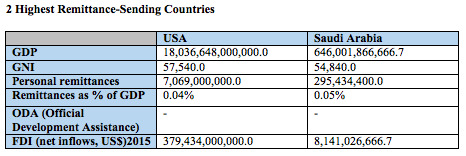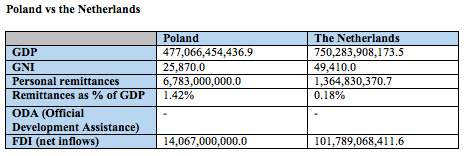With this Tumblr we wish to shed light on the often overlooked economic side of Migration. The political debates of this moment blatantly disregard the consequences of Migration on host and destination country. Therefore, policies that do not reflect the country’s best interest are implemented. We think the root of the problem is miseducation. We hope to educate our viewer of the effects of migration, focusing primarily on our home country, the Netherlands, and therefore the EU. We will be posting educational videos backed up by research articles written by our best and brightest. You will also see graphs and tables obtained with the most recent information available and interviews from people who know their craft. If you have any ideas, questions or submission, please feel free to contact us. All of our posts are visible on this page, however, for a clearer structure, we have also divided them into the six categories at the top of the page! Click on these to see the corresponding posts!
Don't wanna be here? Send us removal request.
Link
0 notes
Link
0 notes
Link
0 notes
Link
0 notes
Link
0 notes
Link
0 notes
Text
KEY TERMS: Migration

Source: IOM, Glossary on Migration, International Migration Law Series No. 25, 2011
Assimilation - Adaptation of one ethnic or social group – usually a minority – to another. Assimilation involves the subsuming of language, traditions, values, mores and behaviour or even fundamental vital interests. Although the traditional cultural practices of the group are unlikely to be completely abandoned, on the whole assimilation will lead one group to be socially indistinguishable from other members of the society. Assimilation is the most extreme form of acculturation.
Asylum seeker - A person who seeks safety from persecution or serious harm in a country other than his or her own and awaits a decision on the application for refugee status under relevant international and national instruments. In case of a negative decision, the person must leave the country and may be expelled, as may any non-national in an irregular or unlawful situation, unless permission to stay is provided on humanitarian or other related grounds.
Border management - Facilitation of authorized flows of persons, including business people, tourists, migrants and refugees, across a border and the detection and prevention of irregular entry of non-nationals into a given country. Measures to manage borders include the imposition by States of visa requirements, carrier sanctions against transportation companies bringing irregular migrants to the territory, and interdiction at sea. International standards require a balancing between facilitating the entry of legitimate travellers and preventing that of travellers entering for inappropriate reasons or with invalid documentation.
Brain drain - Emigration of trained and talented individuals from the country of origin to another country resulting in a depletion of skills resources in the former.
Brain gain - Immigration of trained and talented individuals into the destination country. Also called “reverse brain drain”.
Circular migration - The fluid movement of people between countries, including temporary or long-term movement which may be beneficial to all involved, if occurring voluntarily and linked to the labour needs of countries of origin and destination.
Country of origin - The country that is a source of migratory flows (regular or irregular).
Emigration - The act of departing or exiting from one State with a view to settling in another.
Facilitated migration - Fostering or encouraging of regular migration by making travel easier and more convenient. This may take the form of a streamlined visa application process, or efficient and well-staffed passenger inspection procedures.
Forced migration - A migratory movement in which an element of coercion exists, including threats to life and livelihood, whether arising from natural or man-made causes (e.g. movements of refugees and internally displaced persons as well as people displaced by natural or environmental disasters, chemical or nuclear disasters, famine, or development projects).
Freedom of movement - A human right comprising three basic elements: freedom of movement within the territory of a country (Art. 13(1), Universal Declaration of Human Rights, 1948: “Everyone has the right to freedom of movement and residence within the borders of each state.”), the right to leave any country and the right to return to his or her own country (Art. 13(2), Universal Declaration of Human Rights, 1948: “Everyone has the right to leave any country, including his own, and to return to his country. See also Art. 12, International Covenant on Civil and Political Rights. Freedom of movement is also referred to in the context of freedom of movement arrangements between States at the regional level (e.g. European Union).
Immigration - A process by which non-nationals move into a country for the purpose of settlement.
Internally Displaced Person (IDP) - Persons or groups of persons who have been forced or obliged to flee or to leave their homes or places of habitual residence, in particular as a result of or in order to avoid the effects of armed conflict, situations of generalized violence, violations of human rights or natural or human-made disasters, and who have not crossed an internationally recognized State border (Guiding Principles on Internal Displacement, UN Doc E/CN.4/1998/53/Add.2.). See also de facto refugees, displaced person, externally displaced persons, uprooted people.
Irregular migration - Movement that takes place outside the regulatory norms of the sending, transit and receiving countries. There is no clear or universally accepted definition of irregular migration. From the perspective of destination countries it is entry, stay or work in a country without the necessary authorization or documents required under immigration regulations. From the perspective of the sending country, the irregularity is for example seen in cases in which a person crosses an international boundary without a valid passport or travel document or does not fulfil the administrative requirements for leaving the country. There is, however, a tendency to restrict the use of the term “illegal migration” to cases of smuggling of migrants and trafficking in persons.
Labour migration - Movement of persons from one State to another, or within their own country of residence, for the purpose of employment. Labour migration is addressed by most States in their migration laws. In addition, some States take an active role in regulating outward labour migration and seeking opportunities for their nationals abroad.
Migrant - IOM defines a migrant as any person who is moving or has moved across an international border or within a State away from his/her habitual place of residence, regardless of (1) the person’s legal status; (2) whether the movement is voluntary or involuntary; (3) what the causes for the movement are; or (4) what the length of the stay is. IOM concerns itself with migrants and migration‐related issues and, in agreement with relevant States, with migrants who are in need of international migration services.
Migration - The movement of a person or a group of persons, either across an international border, or within a State. It is a population movement, encompassing any kind of movement of people, whatever its length, composition and causes; it includes migration of refugees, displaced persons, economic migrants, and persons moving for other purposes, including family reunification.
Migration management - A term used to encompass numerous governmental functions within a national system for the orderly and humane management for cross-border migration, particularly managing the entry and presence of foreigners within the borders of the State and the protection of refugees and others in need of protection. It refers to a planned approach to the development of policy, legislative and administrative responses to key migration issues.
Naturalization - Granting by a State of its nationality to a non-national through a formal act on the application of the individual concerned. International law does not provide detailed rules for naturalization, but it recognizes the competence of every State to naturalize those who are not its nationals and who apply to become its nationals.
Orderly migration - The movement of a person from his or her usual place of residence to a new place of residence, in keeping with the laws and regulations governing exit of the country of origin and travel, transit and entry into the destination or host country.
Push-pull factors - Migration is often analysed in terms of the “push-pull model”, which looks at the push factors, which drive people to leave their country (such as economic, social, or political problems) and the pull factors attracting them to the country of destination.
Receiving country - Country of destination or a third country. In the case of return or repatriation, also the country of origin. Country that has accepted to receive a certain number of refugees and migrants on a yearly basis by presidential, ministerial or parliamentary decision.
Refugee - A person who, “owing to a well-founded fear of persecution for reasons of race, religion, nationality, membership of a particular social group or political opinions, is outside the country of his nationality and is unable or, owing to such fear, is unwilling to avail himself of the protection of that country. (Art. 1(A)(2), Convention relating to the Status of Refugees, Art. 1A(2), 1951 as modified by the 1967 Protocol). In addition to the refugee definition in the 1951 Refugee Convention, Art. 1(2), 1969 Organization of African Unity (OAU) Convention defines a refugee as any person compelled to leave his or her country "owing to external aggression, occupation, foreign domination or events seriously disturbing public order in either part or the whole of his country or origin or nationality.” Similarly, the 1984 Cartagena Declaration states that refugees also include persons who flee their country “because their lives, security or freedom have been threatened by generalised violence, foreign aggression, internal conflicts, massive violations of human rights or other circumstances which have seriously disturbed public order.”
Remittances - Monies earned or acquired by non-nationals that are transferred back to their country of origin.
Repatriation - The personal right of a refugee, prisoner of war or a civil detainee to return to his or her country of nationality under specific conditions laid down in various international instruments (Geneva Conventions, 1949 and Protocols, 1977, the Regulations Respecting the Laws and Customs of War on Land, Annexed to the Fourth Hague Convention, 1907, human rights instruments as well as customary international law). The option of repatriation is bestowed upon the individual personally and not upon the detaining power. In the law of international armed conflict, repatriation also entails the obligation of the detaining power to release eligible persons (soldiers and civilians) and the duty of the country of origin to receive its own nationals at the end of hostilities. Even if treaty law does not contain a general rule on this point, it is today readily accepted that the repatriation of prisoners of war and civil detainees has been consented to implicitly by the interested parties. Repatriation as a term also applies to diplomatic envoys and international officials in time of international crisis as well as expatriates and migrants.
Resettlement - The relocation and integration of people (refugees, internally displaced persons, etc.) into another geographical area and environment, usually in a third country. In the refugee context, the transfer of refugees from the country in which they have sought refuge to another State that has agreed to admit them. The refugees will usually be granted asylum or some other form of long-term resident rights and, in many cases, will have the opportunity to become naturalized.
Stateless person - A person who is not considered as a national by any State under the operation of its law” (Art. 1, UN Convention relating to the Status of Stateless Persons, 1954). As such, a stateless person lacks those rights attributable to nationalidiplomatic protection of a State, no inherent right of sojourn in the State of residence and no right of return in case he or she travels.
Xenophobia - At the international level, no universally accepted definition of xenophobia exists, though it can be described as attitudes, prejudices and behaviour that reject, exclude and often vilify persons, based on the perception that they are outsiders or foreigners to the community, society or national identity. There is a close link between racism and xenophobia, two terms that can be hard to differentiate from each other.
0 notes
Text
Website Summary

Here is a brief summary of the content of our website! Like what you see? Then check out our posts! We promise an interesting and educational read for all!
We divided our blog up in five categories, look below for their content:
Under ‘Brief Overview’ we have:
Key Terms
We included a list of terms and their explanations that are needed to fully understand our blog.
Summaries
You are looking at them now :)
Sources
This is a list of the sources we used. Please use them as a platform for further study of you are interested
Under ‘General Education’ we have:
Migration flow interactive map
Check out this interactive map to visualise the vast and continuous migration that exists across the world!
YouTube Informational Video
Check out this youtube video as a great introduction to migration - the history behind it as well as the the benefits and drawbacks of it!
Ted Talk
Check out this interesting TED Talk to learn about advantages of remittances and how they represent a means to development for developing countries!
World Bank Bilateral Remittance Table + additional tables (comparing remittances with other capital flows)
Check out this summary and tables which summarise the importance of remittances in the world economy!
Under ‘Youth Perspective’ we have:
‘What is the first word that comes to your mind when you think about migration?’ video
Check out this video to see what people immediately associate migration with and see how this compares with your associations!
Live Podcast with Lyle Muns
Lyle Muns is the former Youth Leader of Green Left, a leftist Dutch political party, with a strong view on migration. Listen to this interview!
Live Podcast with Lodewijk van der Meer
Lodewijk changed political youth parties. He now affiliates himself with PvDA. As a former Green Left youth party member. His interview creates a new balance with Lyle Muns.
Under ‘Professional Perspective’ we have:
Interview with Anita Blom-Gortzak
Check out this interview to get a professional perspective on the impact of migration on the Netherlands! As an employee at a job centre, she works closely with immigrants on a daily basis, and shares her first hand experience with us!
Under ‘Migration in the Media’ we have:
Recent events montage
Check out this video montage of recent media clips linked to migration! It shows the general trend of how migration has been depicted in the media over the past couple of years!
Uganda
Our post on Uganda investigates Uganda's unique humanitarian approach towards refugee protection. However due to the recent large increase of refugee influx, both host community and refugees are in jeopardy!
Under ‘In-Depth Case Studies’ we have:
EU
Our EU case study explore the documented effects migration has on European countries in: Demographics, Labour markets, Public finances, Balance of Payments and International Competitiveness and growth of a country.
Poland
Check out our post on Poland, a country of origin with regards to migration, which represents a great example of how emigration affects a country!
Netherlands
Our Dutch post balances well with the Poland post, as the Netherlands is a migrant-receiving country. Check out this post to see how immigration affects the Dutch economy!
We hope you like what you see and happy reading!
0 notes
Text
Bibliography: Our Sources

Here is a list of the sources that we used to create the posts of this website! If interested, check out these sources for more information on migration!
1. Breaking Point’ imminent: Government of Uganda, UNHCR say help for
2. South Sudan refugee inflow urgently needed. (2017, March 23). Obtained from unhcr.org: http://www.unhcr.org/news/press/2017/3/58d3abab4/breaking-point-imminent-government-uganda-unhcr-say-help-south-sudan-refugee.html
3. South Sudan. (2017, February 28). Obtained from data.unhcr.org: http://data.unhcr.org/SouthSudan/country.php?id=229
4. Zorlu, A., & Hartog, J. (2001). Migration and immigrants: the case of the Netherlands (No. 01-042/3). Tinbergen Institute Discussion Paper.
5. Taylor, E. J. (1999). The new economics of labour migration and the role of remittances in the migration process. International migration, 37(1), 63-88.
6. Roodenburg, H. J., Euwals, R. W., & Rele, H. J. M. (2003). Immigration and the Dutch economy (Vol. 26). The Hague: CPB.
7. Kloosterman, R., Van der Leun, J., & Rath, J. (1998). Across the border: Immigrants’ economic opportunities, social capital and informal business activities. Journal of ethnic and migration studies, 24(2), 249-268.
8. Kloosterman, R., Van der Leun, J., & Rath, J. (1999). Mixed embeddedness:(in) formal economic activities and immigrant businesses in the Netherlands. International journal of urban and regional research, 23(2), 252-266.
9. Van der Waal, J. (2013). Foreign direct investment and international migration to Dutch cities. Urban Studies, 50(2), 294-311.
10. Münz, R., Straubhaar, T., Vadean, F. P., & Vadean, N. (2006). The costs and benefits of European immigration (No. 3). HWWI Policy Report.
11. Kaczmarczyk, P., and M. Okolski. "Demographic And Labour-Market Impacts Of Migration On Poland". N.p., 2017. Print.
12. "The Economist". N.p., 2017. Web. 16 Apr. 2017. http://www.economist.com/blogs/easternapproaches/2013/11/poland-and-eu
13. "Focus-Migration: Poland". Focus-migration.hwwi.de. N.p., 2017. Web. 2 Apr. 2017.
14. "World Bank Databank". Databank.worldbank.org. N.p., 2017.
15. "CSO - Central Statistics Office". Cso.ie. N.p., 2017. Web. 16 Apr. 2017.
16. Ratha, Dilip. "The Hidden Force In Global Economics: Sending Money Home". Ted.com. N.p., 2017. Web. 16 Apr. 2017.
17. "Mapping The World's Migration Flows". Metrocosm.com. N.p., 2017. Web. 7 Apr. 2017.
0 notes
Link
Check out this great interactive map which visualises the extent of the World’s migration!
The map shows the estimated net migration (inflows minus outflows) by origin and destination country between 2010 and 2015. The blue circles represent positive net migration (more inflows than outflows) while the red circles represent negative net migration (more outflows than inflows). Each yellow dot represents 1,000 people. Hover over a circle to see that country’s total net migration between 2010 and 2015. To view only the migration flows in and out of that one country, click on a circle.
0 notes
Video
youtube
Economic debate: Is immigration good or bad?
Check out this youtube video which gives a great overview of the history of migration, the importance of migration in our current world as well as the economic debate of whether migration is good or bad!
0 notes
Link
Check out this interesting Ted Talk by Dilip Ratha which describes the concept of ‘remittances’ as a key benefit of migration. Ratha highlights the economic importance of remittances in developing countries as a mean for development; to give a surprising example, in 2013, 413 billion dollars in remittances were sent to developing countries compared to the 135 billion dollars in aid sent to developing countries. In addition, Ratha points out the common, significant mistake that is made which is to view remittances as ‘small change’ instead of the ‘rivers of foreign currency’ that they actually are. Remittances have huge impacts on economies and people and, unlike private investment money, do not flow back at the first sign of trouble in the country - remittances, in fact, act like an insurance. Unlike development aid money that must go through official agencies through governments, remittances directly reach the poor and often with business advice. Ratha gives various interesting examples of the extensive benefits of remittances, for instance in the case of Nepal. Lastly, Ratha also discusses the barriers that actually exist to remittance flows, how these barriers limit the positive impacts of remittances and he explains how these must be abolished since they are significantly hindering the development of countries. An example of a barrier are the high costs of sending money back home - money transfer companies are earning large amounts from remittances by taking a proportion of the money as a transfer cost; without these costs on remittances, remittances would have a significantly larger positive impact on developing countries. This TED Talk demonstrates a key argument that promotes a positive image of migration and visualises the large influence that migrant remittances have on developing countries.
0 notes
Link

Check out this table (the link is above in the title of the post) found on the World Bank website which displays all countries in the world and estimates of the amount of remittances they received in 2015! The columns (across) represent the remittance-receiving countries and the rows (down) represent the remittance-sending countries. This breakdown really highlights the countries where high emigration occurs (i.e. large amount of a country’s population live abroad and therefore, they receive high remittances from around the world) and so, the countries whose GDP is highly dependent on remittances. The table also gives us a general image of the vast contribution remittances have on the world economy - remittances contributed 580,594 million US$ to the world economy in 2015!
If we consider the remittance-receiving countries, we can conclude that India (68,910 million US$) and China (63.938 million US$) receive the highest amount of remittances in the world. For India, the largest amount of remittances comes from United Arab Emirates (13,745 million US$) and USA (11,736 million US$) whilst for China, the largest amount of remittances comes from the USA (16,234 million US$). A large amount of Indian and Chinese people live abroad (which also corresponds to their large population sizes) and the money that they send back in the form of remittances is a significant contribution to the GDP. To picture this better, India for instance had a GDP of 2059.4 billion US$ in 2015 which means that remittances represented 3.35% of India’s GDP in 2015.
On the other hand, if we consider the remittance-sending countries, we can conclude that USA (134,961 million US$) and Saudi Arabia (46,962 million US$) send the largest amount of remittances back out to the rest of the world. For them, the remittances represent money that is lost from their economies and sent back to immigrants’ home countries. For the USA, the largest proportion of remittances are sent back to Mexico (25,675 million US$) and China (16,234 million US$). For Saudi Arabia, the largest proportion of remittances are sent back to India (11,253 million US$) and Egypt/Arab Rep. (7,076 million US$). To picture this better, USA for example had a GDP of 18036.65 billion US$ in 2015 which means that the money lost from the economy in the form of remittances would have increased the GDP of USA by 0.75%.
Remittances have an immense influence on the world economy and on the GDP of single countries (as described above) and this table provides a great summary of this!
0 notes
Text
Country overviews: India, China, USA, Saudi Arabia, Poland, the Netherlands
Check out these tables that we made which summarise the importance of remittances in 6 different countries, in relation to other economic indicators! All information was gathered from the World Bank DataBank and are the latest figures available, from 2015. All figures are presented in US$.
Table 1 - This table displays figures for the two highest remittance-receiving countries, as found in the Bilateral Remittance Matrix: India and China

Table 2 - This table displays figures for the two highest remittance-sending countries, as found in the Bilateral Remittance Matrix: USA and Saudi Arabia

Table 3 - This table displays figures for the two countries we analysed in our in-depth case studies of our website: Poland and the Netherlands. Use this table as additional information to our case studies!

0 notes
Video
youtube
Migronomics Video: What is the first word that comes to mind when you think about migration?
We have created this video to demonstrate the varying thoughts that the word ‘migration’ evokes in different people. We were curious to see whether migration generally has a more positive or more negative image in the eyes of a young population. The words ‘refugee’ and references to ‘Trump’ were repeated several times and this negative image of migration is exactly what we hope to address and remove with our website. The vast benefits and positive aspects of migration are often forgotten about when we first think about migration due to current media attention on the Syrian refugee crisis as well as Trump’s presidency, including his radical policies towards immigrants. With this website, we will demonstrate how advantageous migration also is, looking into what the consequences of migration flows are to host and destination countries as well as which sectors/industries benefit from it. We will focus on the economic impact of migration and will use the various in-depth case studies.
0 notes
Video
youtube
Migronomics Podcast: Lyle Muns
Check out our Migronomics podcast where we discuss the topic of migration with Lyle Muns, former youth president of ‘Groen Links’!
0 notes
Video
youtube
Migronomics Podcast: Lodewijk van der Meer
Check out our second Migronomics podcast where we discuss the topic of migration with Lodewijk van der Meer, an active member of the PvdA political youth organisation!
0 notes